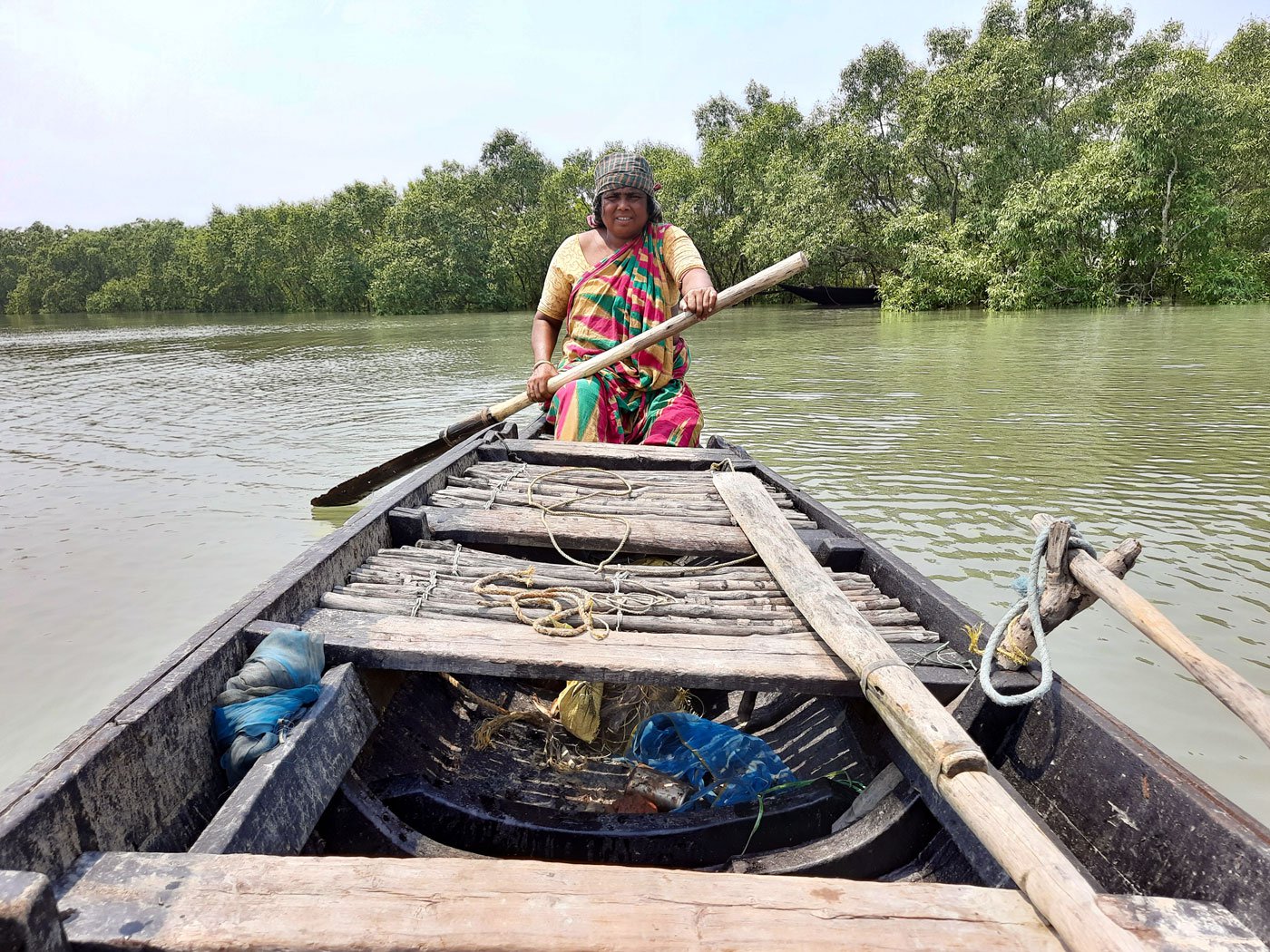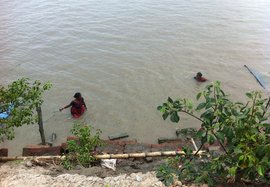“How do I describe my fear? My heart races in terror. My thoughts are always on when I will escape back to open spaces,” says 41-year-old crab hunter and fisherwoman Parul Haldar, about the cold fear she feels during the days that she searches for crabs to catch in the dense mangrove forests of the Sundarbans. During the crab-hunting season, she rows a boat up and down the rivulets and creeks through the mangrove forest, always in a state of high alert for lurking tigers.
Now directing her wooden boat down the Garal river, Parul, a resident of Luxbagan village, squints in the direction of the criss-cross net fence beyond which lies the Marichjhapi forest. It was in this forest, near her village in the Gosaba block of the South 24 Parganas district, that Parul’s husband, Ishar Ronojit Haldar, was killed by a tiger seven years ago.
She rests the oars on the edges of the boat in which she and her mother Lokhi Mondal, 56, are out on a scorching summer day. Like her daughter, Lokhi is a fisherwoman too.
Parul was only 13 years old when she married Ishar. Her marital family was poor, but they had never gone into the forest to fish or catch crabs. “I convinced him to come and brought him to the jungle,” she recalls. “Seventeen years later, he died in the jungle.”
Parul lapses into silence at the memory. Ishar was 45 when he died, leaving Parul to raise their four daughters.
Parul and Lokhi pull the heavy oars again, sweating. The women steer the boat a safe distance away from the mangrove forest, now closed for fishing. Fishing activities in the mangrove forest are closed for three months, from April to June, to allow regeneration of fish. When the fishing season is paused, Parul usually sells fish from her pond for a living.
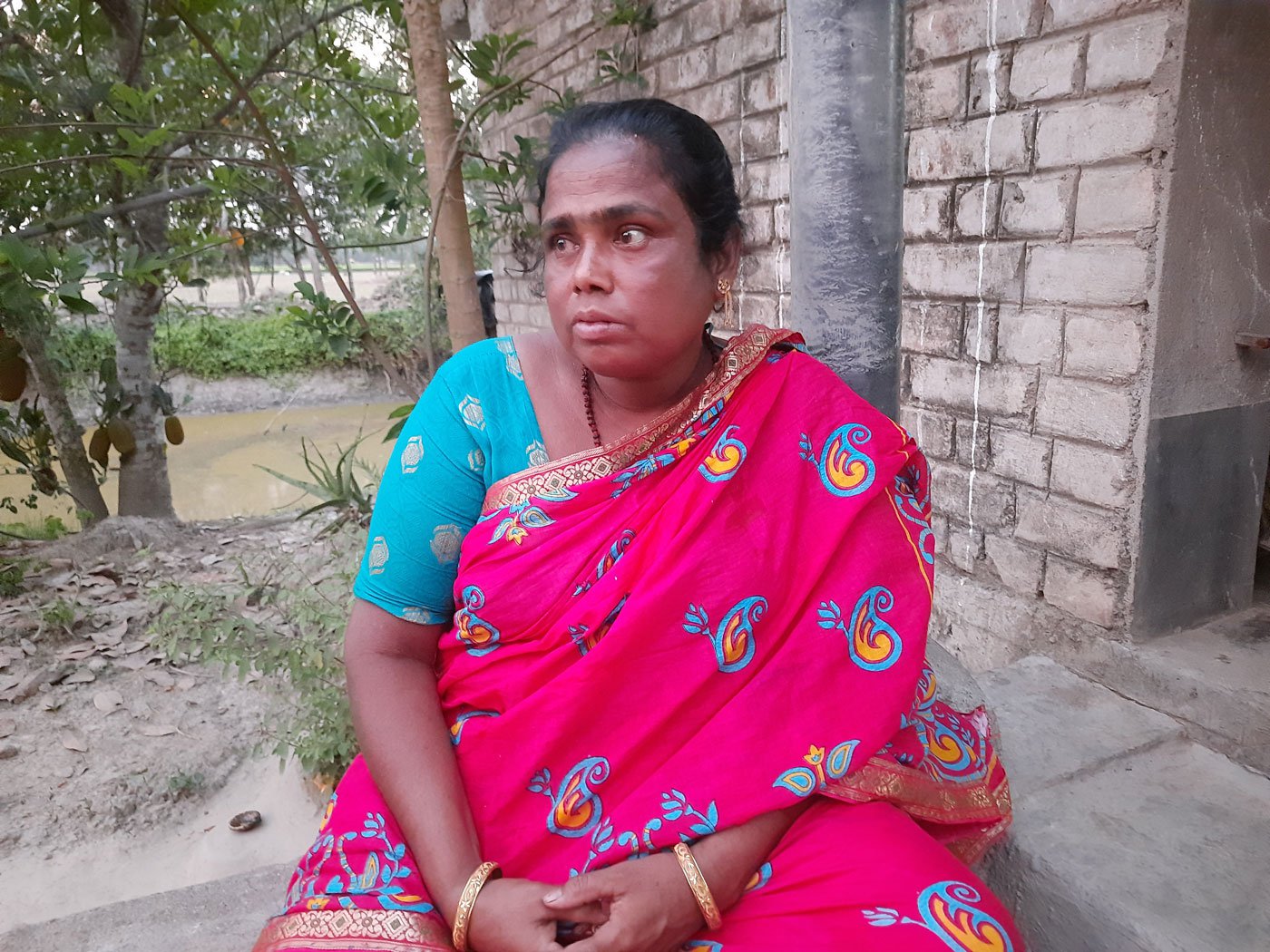
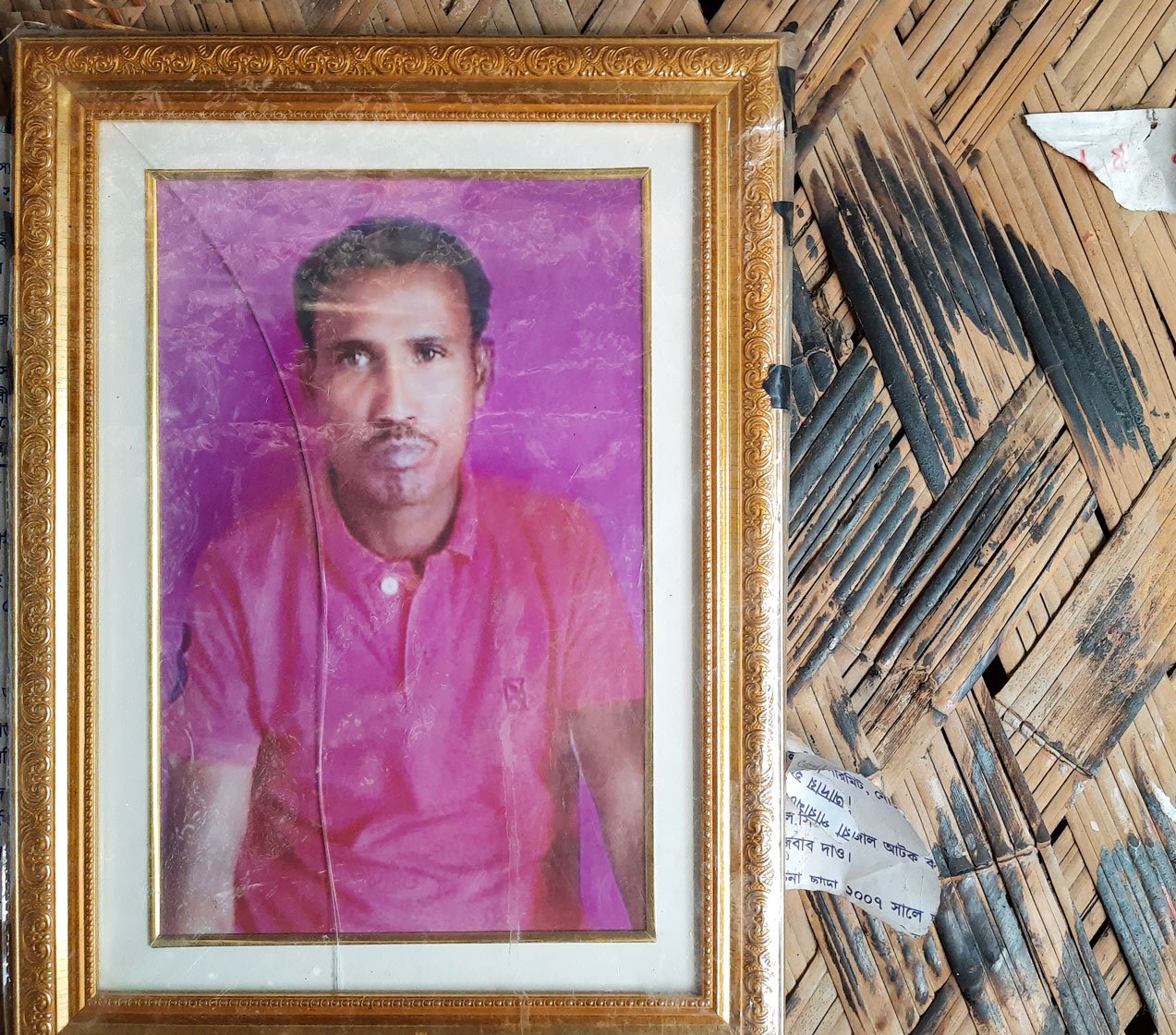
Left: Parul Haldar recalls the death of her husband, Ishar Haldar. Right: A picture of Ishar Ronojit Haldar who was killed by a tiger in 2016
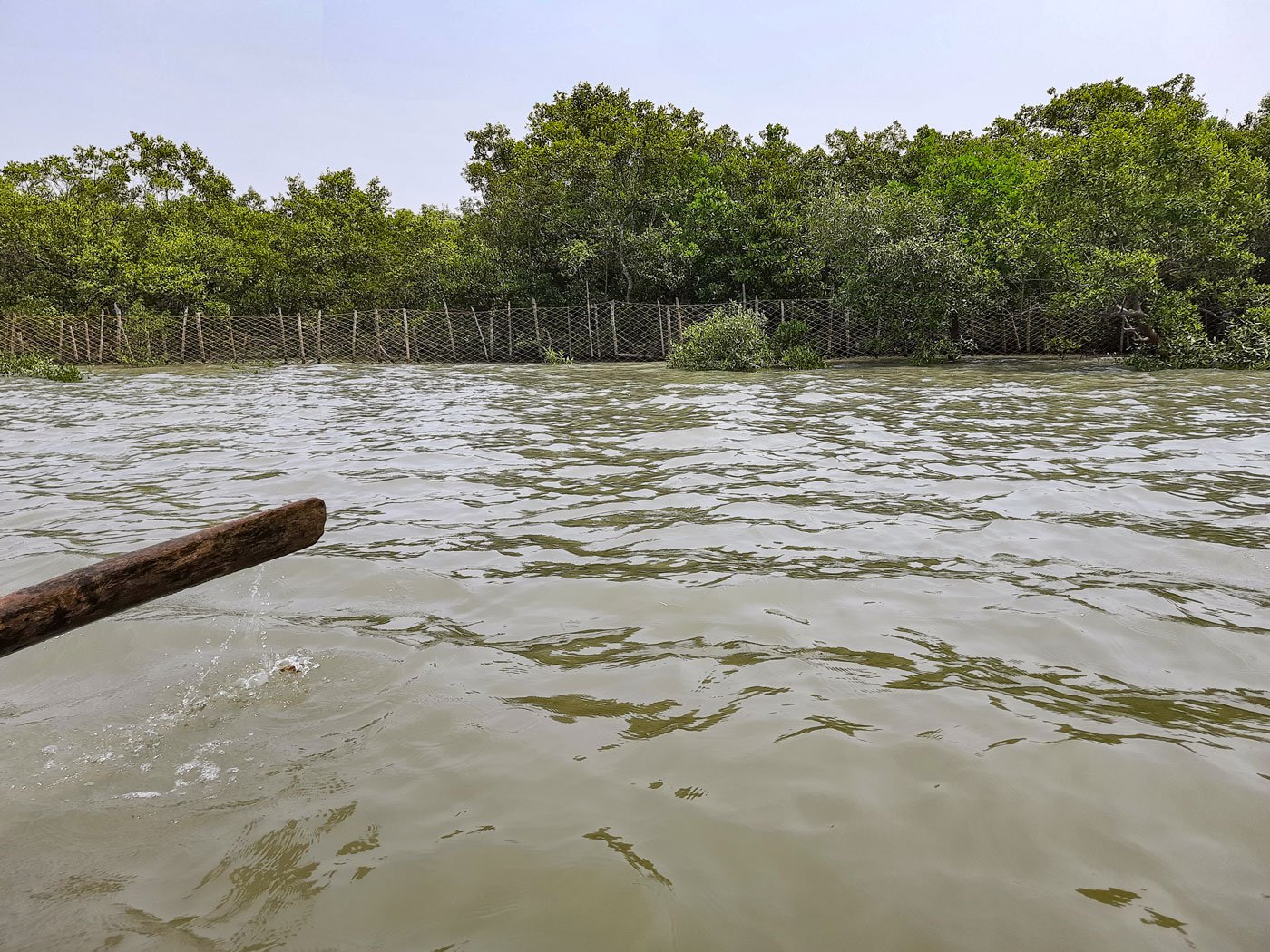
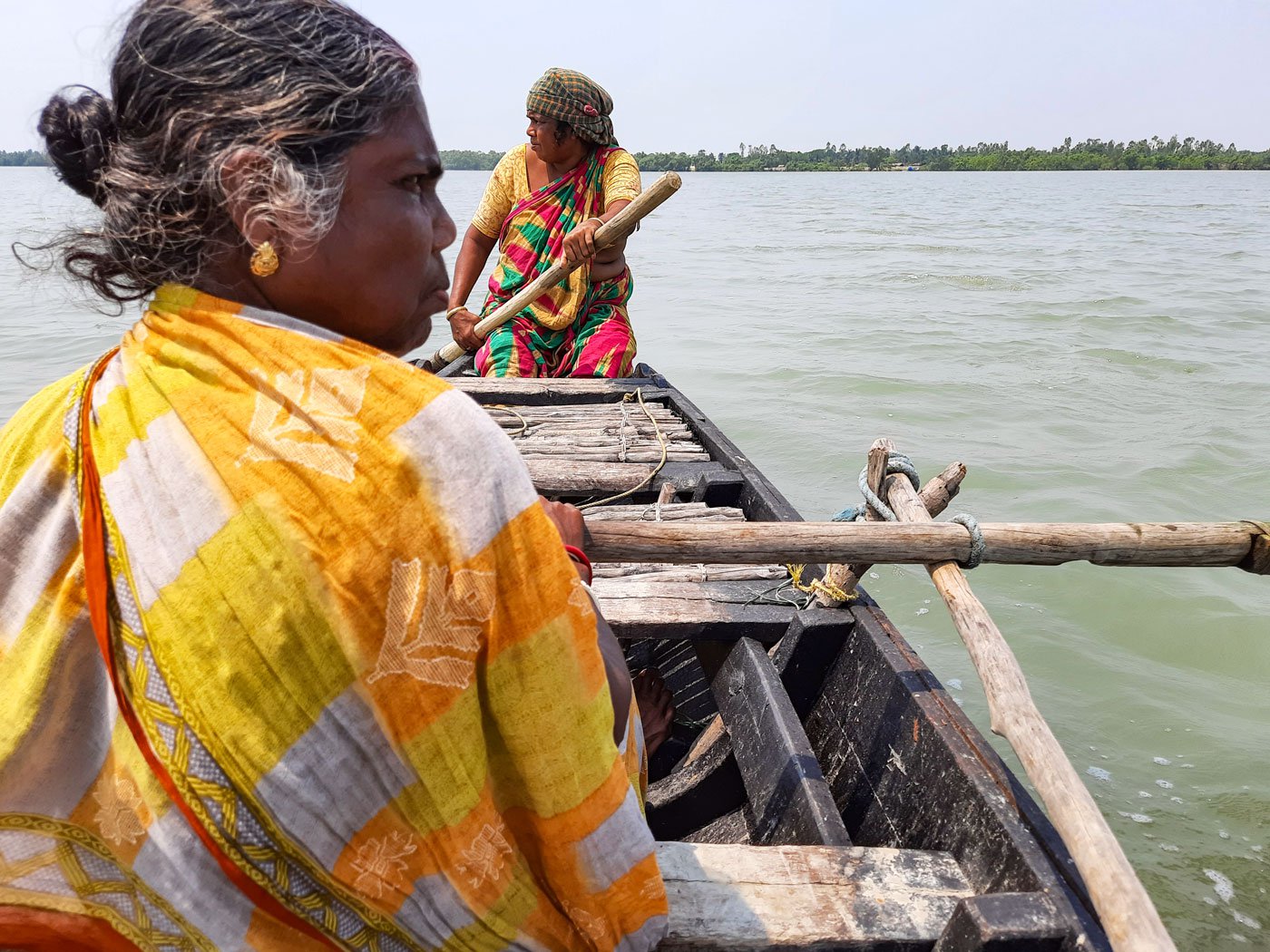
Left: A cross netted fence, beyond which lie the Marichjhapi forests in South 24 Parganas district. Right: Parul (background) learned fishing from her mother and Lokhi (yellow sari foreground) learned it from her father
“Many accidents are happening,” Parul says, referring to attacks by the Bengal tigers in the Sundarbans, the only mangrove forest in the world inhabited by tigers. “Too many people are entering the forest and accidents are increasing. This is another reason why forest authorities are not allowing us to enter the forest.”
Tiger-related deaths are not uncommon in the Sundarbans, especially during the fishing season. The government reported only 12 deaths in the Sundarbans Tiger Reserve Between 2018 and January 2023, but actual numbers may be higher, with local residents reporting more instances of attacks.
According to the government’s Status of Tigers Report, the Sundarbans was home to 100 tigers in 2022 , compared to 88 in 2018.
*****
Parul has been fishing since she was 23 years old, having learnt how to fish from her mother.
Lokhi started fishing when she was only seven years old, accompanying her father to the forest. Her husband Santosh Mondal, 64 fought off a tiger in 2016 and managed to return home alive.
“He had a knife in his hand and fought the tiger. But after that incident, his courage broke, and he refused to go to the forest any more,” says Lokhi. She, however, did not stop. Once her husband stopped going, she began to make the journey into the forest with Parul and her son-in-law, Ishar, who later died.
“I don’t have the courage to go to the jungle with anyone else. Nor do I allow Parul to go alone. As long as I am alive, I will accompany her,” she says. “Only your own blood can protect you in the jungle.”
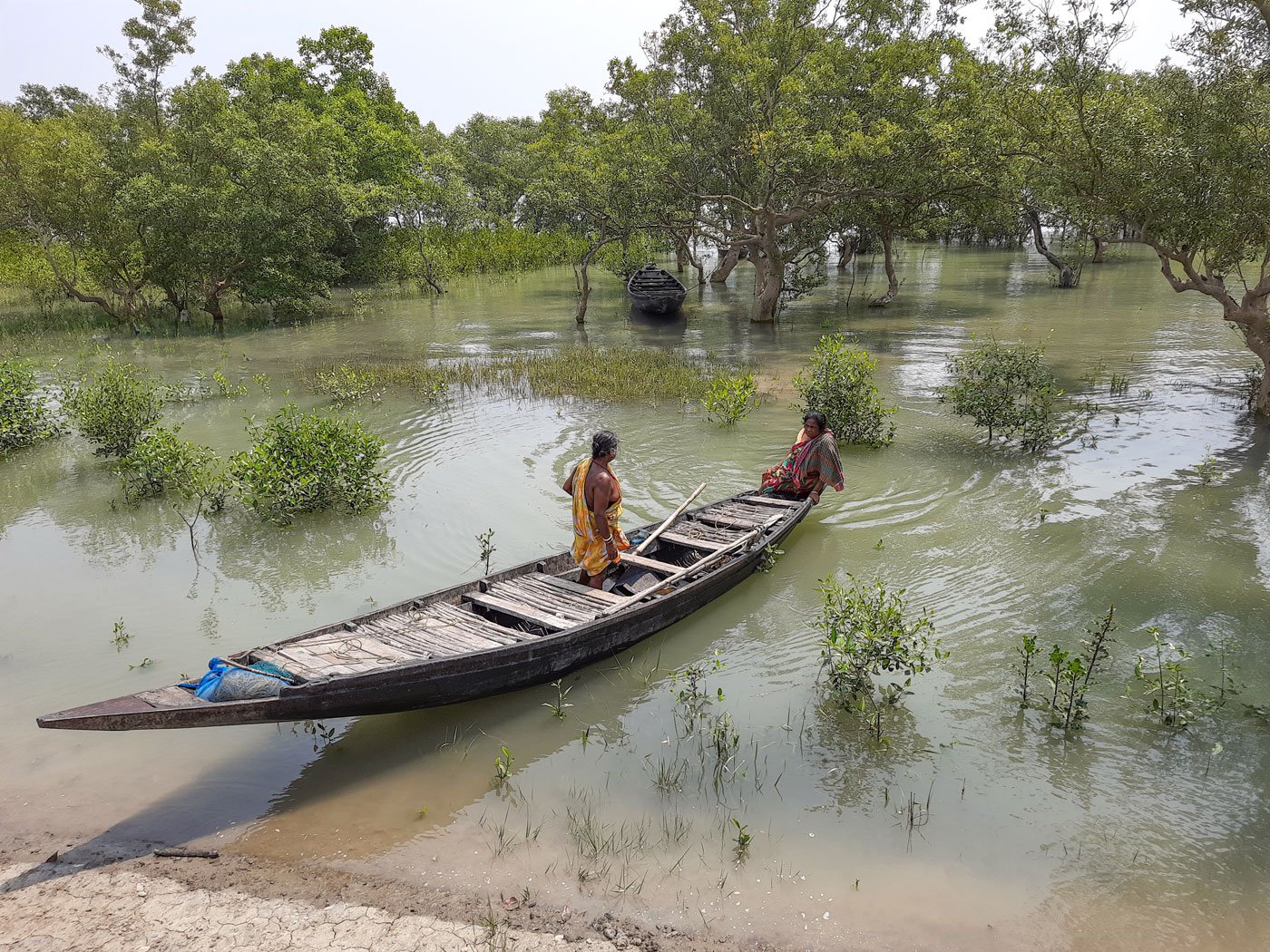
As the number of crabs decrease, Parul and Lokhi have to venture deeper into the mangrove forests to find them
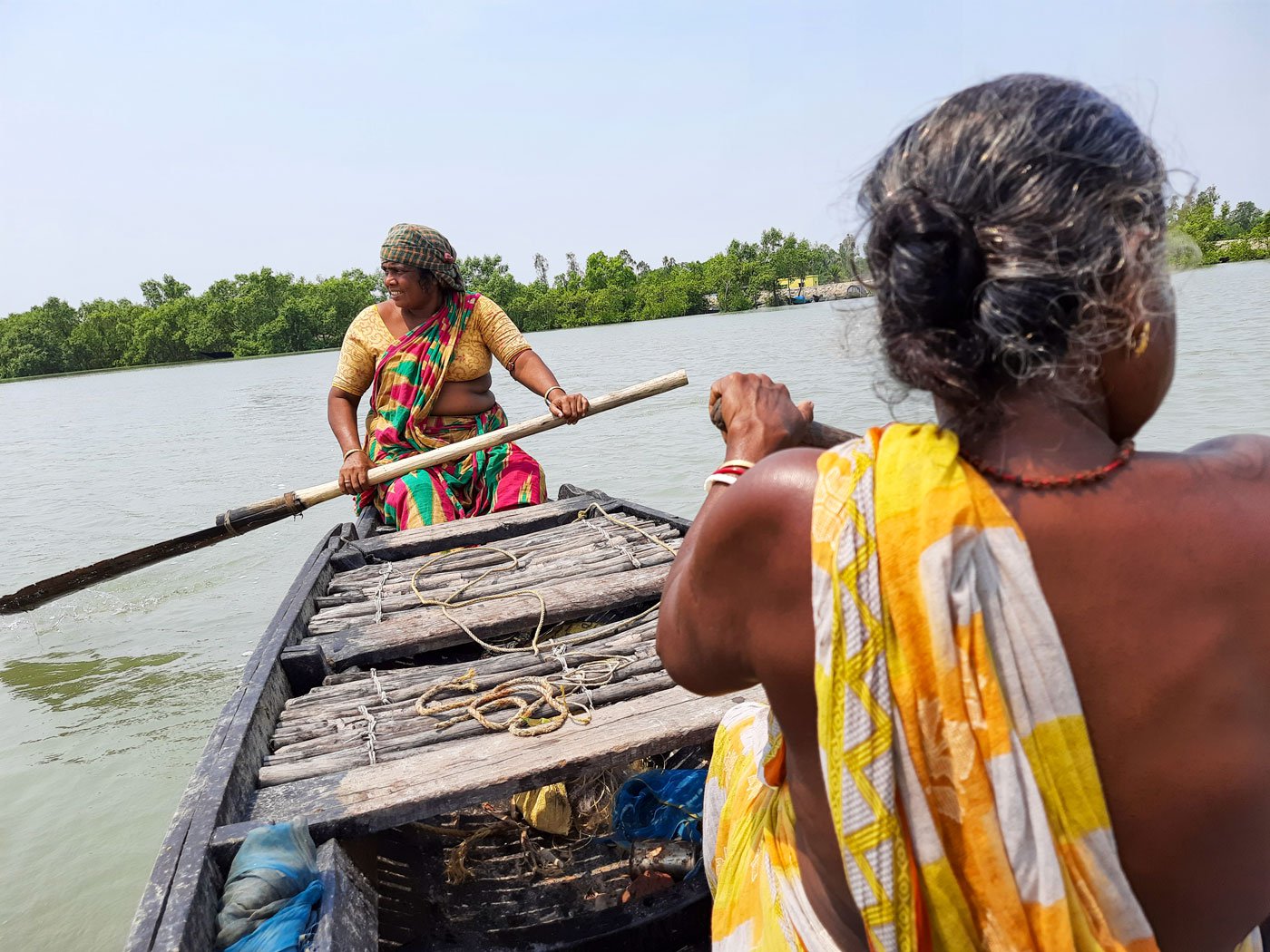
Parul and Lokhi rowing across the River Garal
The two women row in tandem, without needing to converse. Once the crab hunting season starts, they will need to obtain passes from the forest department and rent a boat to take to the forest.
Parul pays Rs. 50 per day in rent. Usually, they are joined by a third woman. The three women must stay in the forest for at least 10 days. “We sleep and eat in the boat and cook our meals on it. We carry rice and dal, drinking water in drums and a small stove. We do not leave the boat under any circumstances, not even to go to the toilet,” Parul says. The rising incidence of tiger attacks, she says, are the main reason.
“Tigers now even climb on to the boats and take human beings away. My own husband was attacked in a boat.”
For the ten days that they are out fishing, the women live on the boats even in the rain. “The crabs are in one corner of the boat, the humans in another, and the cooking in a third corner,” Lokhi adds.
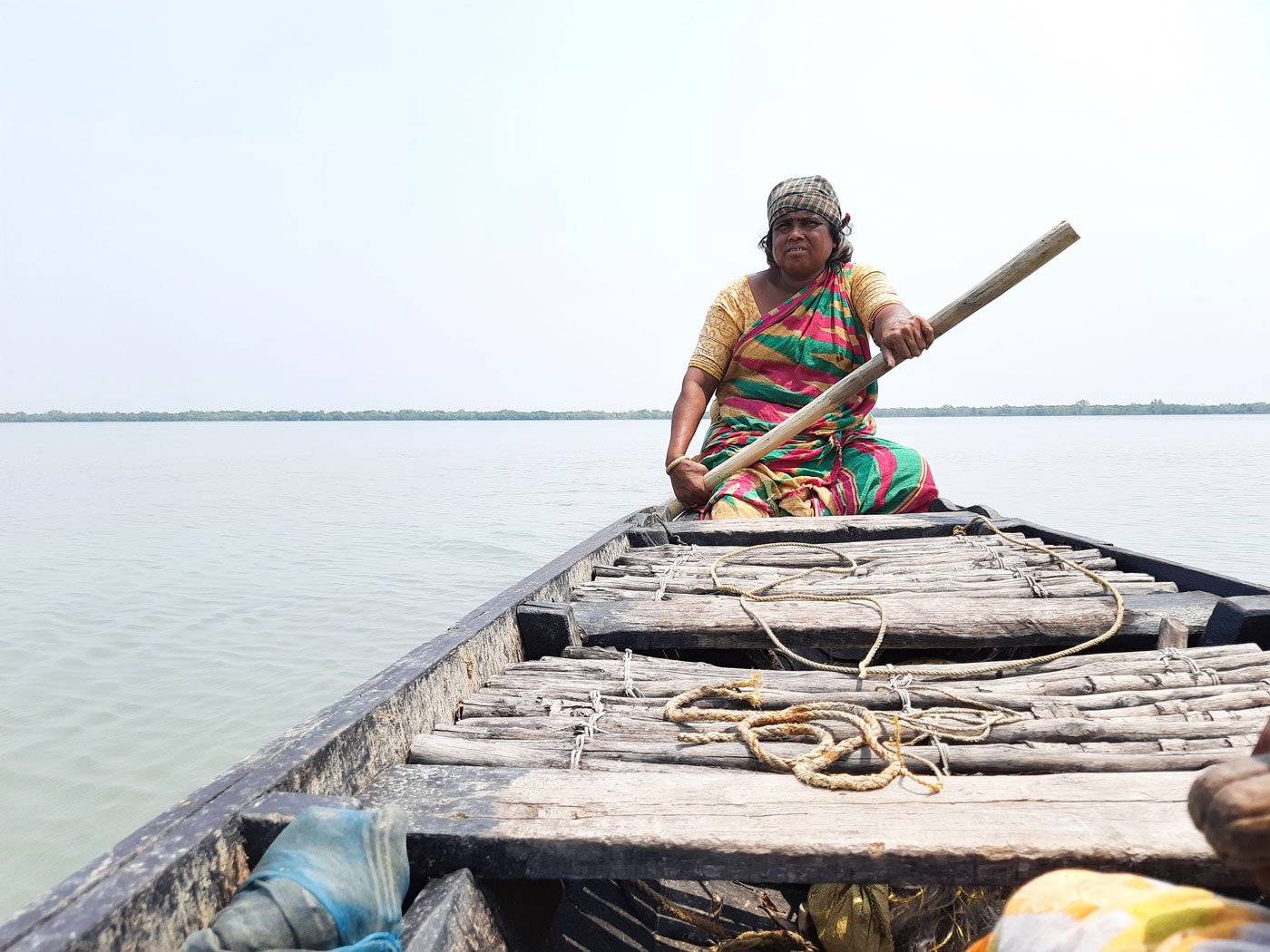
"We do not leave the boat under any circumstances, not even to go to the toilet,” says Parul
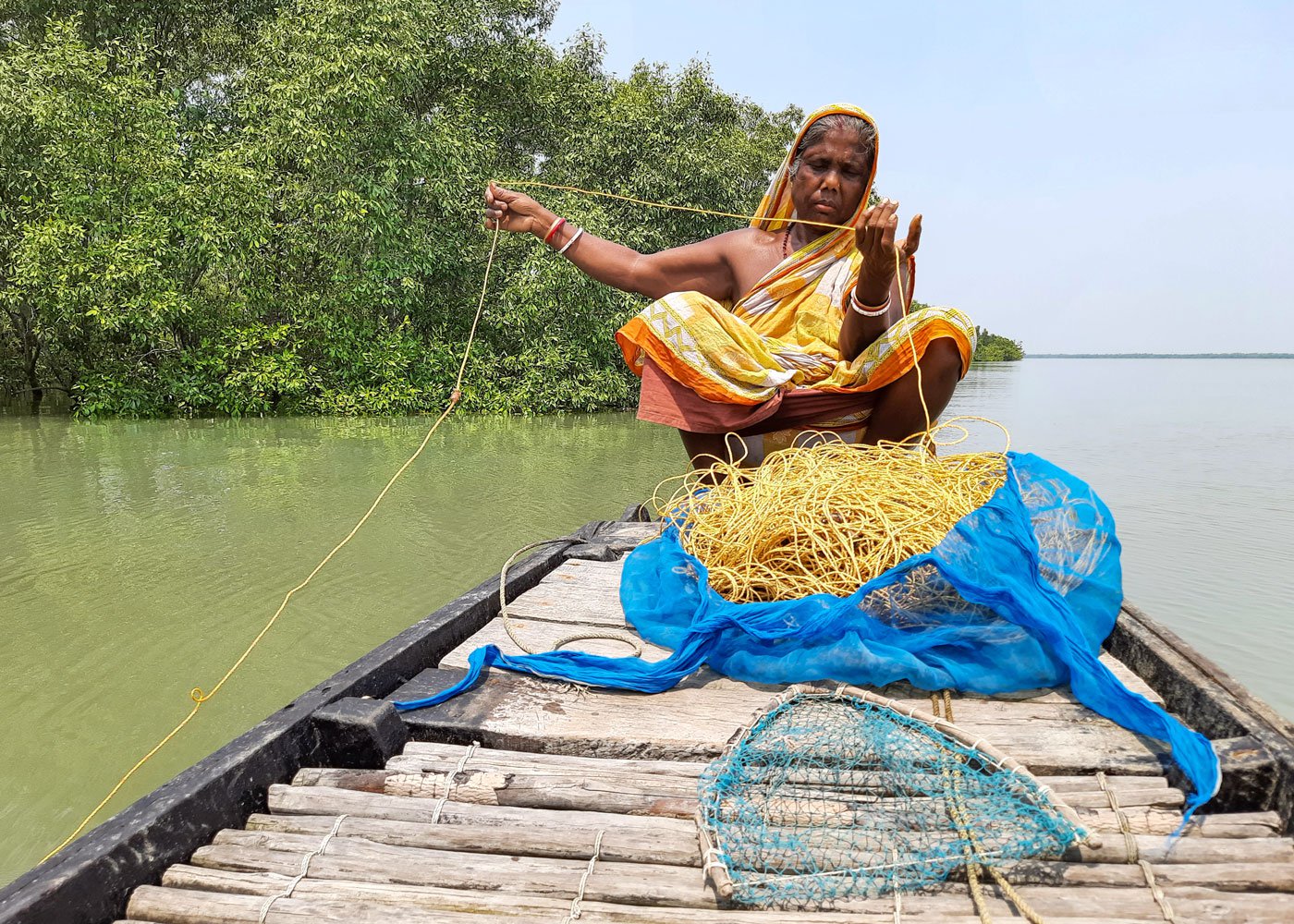
Lokhi Mondal demonstrating how to unfurl fishing nets to catch crabs
Like their male counterparts who frequent the jungles, women are also vulnerable to attacks by tigers while out fishing. However, there are no estimates of how many women have been killed in the Sundarbans, considered a hotspot for man-animal conflict.
“Most of the recorded deaths are of men. Women too are attacked by tigers but the data hasn’t been collected. Women go to the forests, of course, but in fewer numbers compared to men,” says Pradeep Chatterjee, convenor of the National Platform For Small-Scale Fish Workers. Proximity to the forest is an important factor. Women whose villages are located a good distance away from the forest tend not to go. They also undertake the journey only when enough other women are making the trip too.
In Parul and Lokhi’s village of Luxbagan, whose population was 4,504 according to the Census 2011 including approximately 48 percent women, nearly every household has women who go to the Marichjhapi forest, just 5 km from the village.
The good prices that crabs fetch are also a major draw for this high-risk work. “Selling fish doesn’t earn me much. Crabs fetch the main income. I can earn anything between Rs. 300-500 daily when I go to the forest,” Parul says. The bigger crabs fetch Rs. 400-600 a kg while the smaller ones go for Rs. 60-80 per kg. The combined catch of three women on a trip can be anything between 20-40 kg.
*****
Apart from the risk posed by tigers, the other big challenge faced by crab-catchers in the Sunderbans is the dwindling catch. “More people are coming to the jungle to catch crabs. Earlier crabs would be in plenty, now we have to work harder to find them,” says Parul.
As the number of crabs shrink, fisherwomen are forced to go deeper into the forests where the risk of being attacked by a tiger increases.
Chatterjee said the fisher-people of the region have begun to venture deep into the mangrove forests to find an adequate quantity of fish or crabs and there they are coming into confrontations with tigers. “Forest authorities only focus on tiger conservation. But if the fish don’t survive, tigers won’t survive either,” Chatterjee says. “Human-wildlife conflict can reduce if the fish in the rivers increases.”
After returning from the river, Parul busies herself in making lunch. She cooks fish that she has caught from her pond, boils the rice and stirs sugar into a mango chutney.
She doesn’t like eating crabs, she says. Her mother Lokhi joins the conversation. “Neither me nor my daughter eat crabs,” she says. Asked why, she doesn’t provide details, but mentions “accidents”, a reference to her son-in-law Ishar’s death.
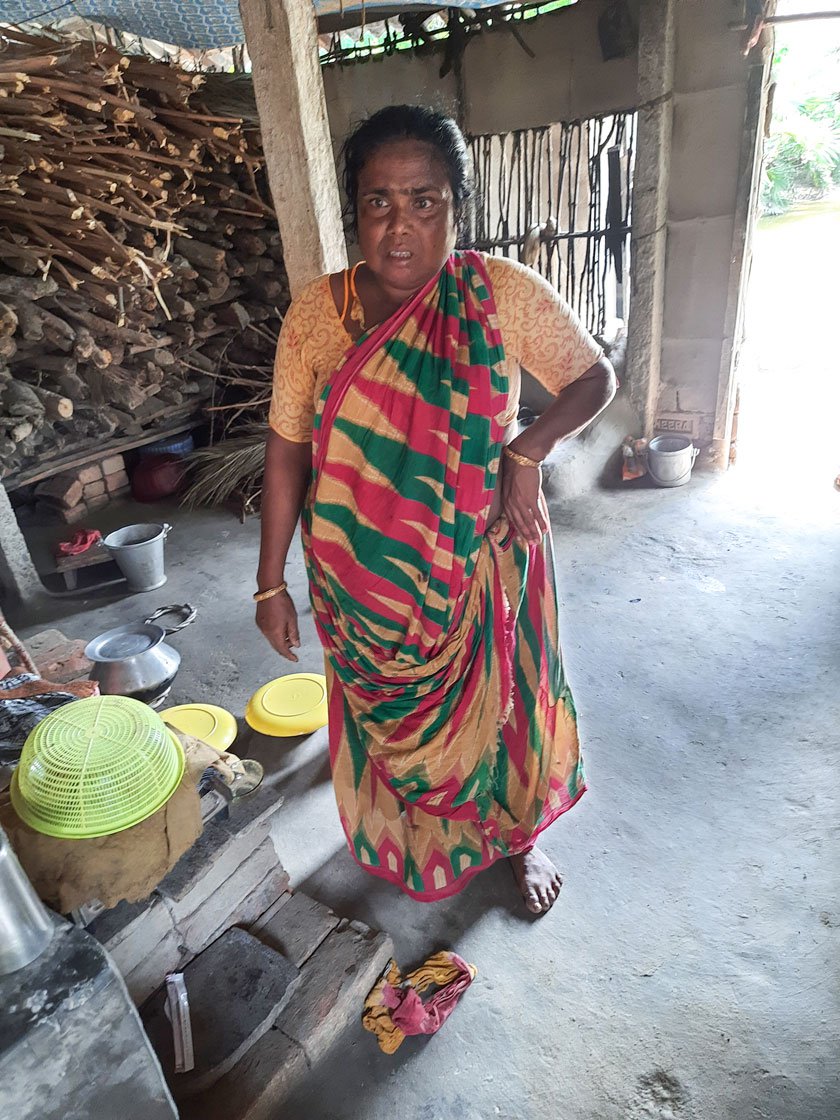
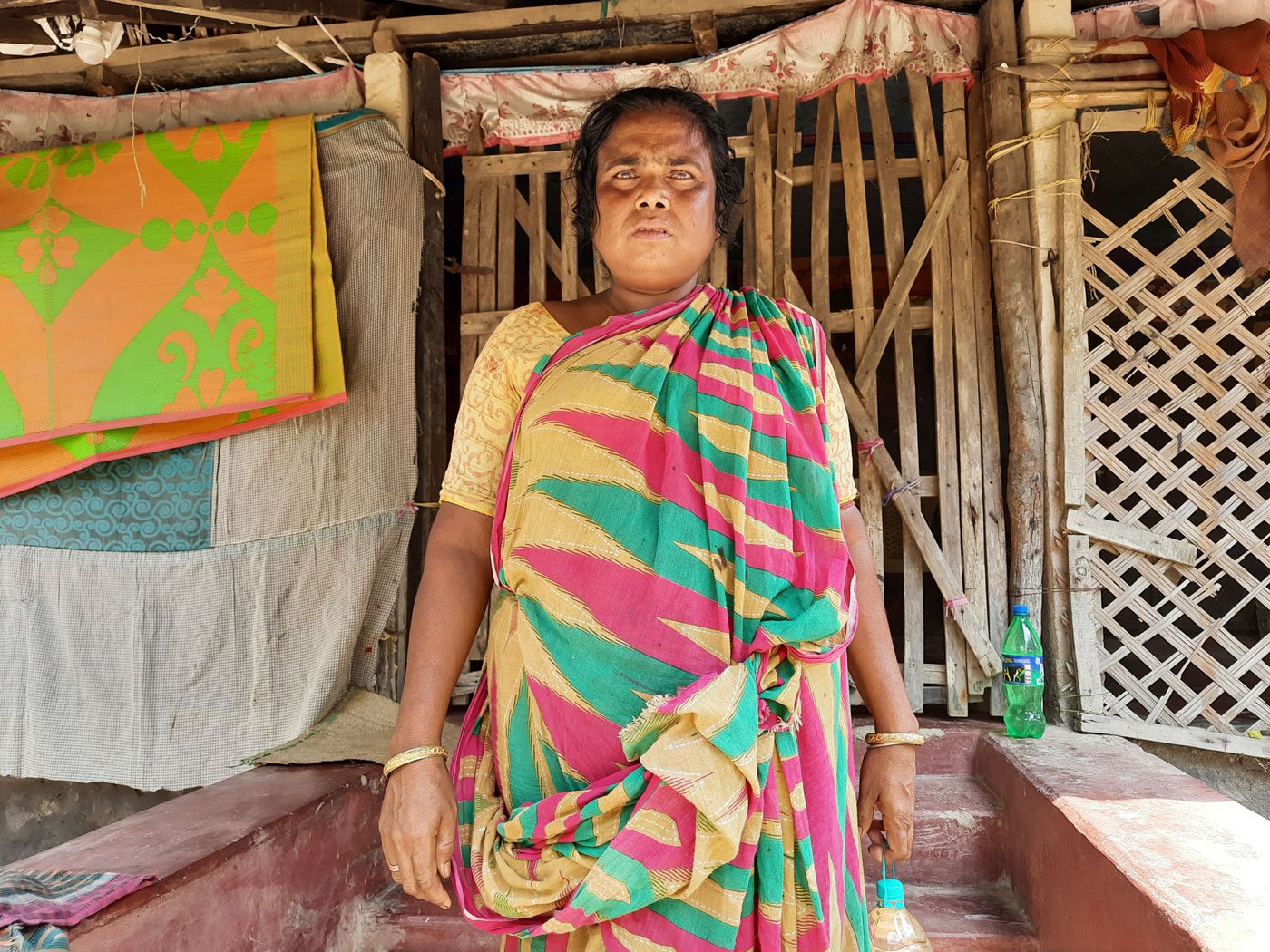
Parul at home in her village Luxbagan, South 24 Parganas. None of her daughters work in the forest
None of Parul’s four daughters, Pushpita, Paromita, Papiya, and Papri, works in the forest. Pushpita and Papiya work at people’s houses in other districts of West Bengal while Paromita works for a private company in Bengaluru. The youngest, Papri, 13, stays in a hostel near Luxbagan but is sickly. “Papri had typhoid and malaria, so I had to spend Rs. 13,000 on her treatment. I also pay for her hostel fees of Rs. 2,000 each month,” Parul says.
Parul herself is unwell. She has chest pains and cannot go fishing or crab hunting this year. She now lives with her daughter Paromita Mistry, in Bengaluru.
“A doctor in Kolkata asked me to do MRI scans that cost Rs. 40,000. I do not have so much money,” she says. She decided to travel to the southern city and live with her daughter and son-in-law, who both work for private companies. Parul also consulted a doctor in Bengaluru, who prescribed rest and medicines for six months.
“I think the pains in my chest started due to the fear I constantly feel, especially when I go to the forest. My husband was killed by a tiger, and my father too was attacked. That is what caused the chest pains,” she says.
